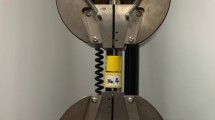Abstract
To investigate the effects of new two low-shrinkage composites SDR® and Venus®Bulk Fill on the cell viability, cellular damage and expression of mesenchymal markers on dental stem cells. Specimens from two low-shrinkage composites were eluted with culture medium for 24 h. After 24 h of incubation, cytotoxicity of elutes were evaluated by MTT assay; apoptosis was determined using the DNA-specific fluorochrome Hoechst 33342 and the mesenchymal stem cells markers expression was analyzed by immunofluorescence staining. After 24 h of cell exposure to each extract media, dental stem cells expressed MSCs markers. The interaction among the material and cell line was not significantly correlated [F(1,60) = 2.251, P = 0.39], whereas statistically significant differences among cells lines were observed [F(1,60) = 9.157, P = 0.004], being dental pulp stem cells more resistant that periodontal ligament stem cells. Also, we did not find any significant effect between the tested materials [F(1,60) = 0.090, P = 0.765]. Furthermore, a very low proportion of exposed cells showed condensed or fragmented nuclei, typical of apoptotic cells at 24 h. The results suggest that SDR® and Venus® Bulk fill and should be considered when selecting an appropriate resin-based dental restorative material.







Similar content being viewed by others
References
Geurtsen W. Biocompatibility of resin-modified filling materials. Crit Rev Oral Biol Med. 2000;11:333–55.
Geurtsen W. Toxicology of dental materials and ‘clinical experience’. J Dent Res. 2003;82:500.
Quinlan CA, Zisterer DM, Tipton KF, O’Sullivan MI. In vitro cytotoxicity of a composite resin and compomer. Int Endod J. 2002;35:47–55.
Mjor IA. Current views on biological testing of restorative materials. J Oral Rehabil. 1990;17(6):503–7.
Issa Y, Watts DC, Brunton PA, Waters CM, Duxbury AJ. Resin composite monomers alter MTT and LDH activity of human gingival fibroblasts in vitro. Dent Mater. 2004;20:12–20.
Flury S, Hayoz S, Peutzfeldt A, Hüsler J, Lussi A. Depth of cure of resin composites: is the ISO 4049 method suitable for bulk fill materials? Dent Mater. 2012;28:521–8.
Hanks CT, Strawn SE, Wataha JC, Craig RG. Cytotoxic effects of resin components on cultured mammalian fibroblasts. J Dent Res. 1991;70:1450–5.
Ausiello P, Cassese A, Miele C, Beguinot F, Garcia-Godoy F, Di Jeso B, et al. Cytotoxicity of dental resin composites: an in vitro evaluation. J Appl Toxicol. 2011. doi: 10.1002/jat.1765.
Donadio M, Jiang J, He J, Wang YH, Safavi KE, Zhu Q. Cytotoxicity evaluation of Activ GP and Resilon sealers in vitro. Oral Surg Oral Med Oral Pathol Oral Radiol Endod. 2009;107(6):e74–8.
Jafarnia B, Jiang J, He J, Wang YH, Safavi KE, Zhu Q. Evaluation of cytotoxicity of MTA employing various additives. Oral Surg Oral Med Oral Pathol Oral Radiol Endod. 2009;107:739–44.
Gorduysus M, Avcu N, Gorduysus O, Pekel A, Baran Y, Avcu F, et al. Cytotoxic effects of four different endodontic materials in human periodontal ligament fibroblasts. J Endod. 2007;33:1450–4.
Ulker HE, Hiller KA, Schweikl H, Seidenader C, Sengun A, Schmalz G. Human and bovine pulp-derived cell reactions to dental resin cements. Clin Oral Investig. 2012;16(6):1571–8.
ISO 10993-5. Biological evaluation of medical devices. Part 5. Test for in vitro cytotoxicity. 2009.
ISO 10993-12. Biological evaluation of medical devices. Part 12: sample preparation and reference materials. 2007.
Illeperuma RP, Park YJ, Kim JM, Bae JY, Che ZM, Son HK, et al. Immortalized gingival fibroblasts as a cytotoxicity test model for dental materials. J Mater Sci Mater Med. 2012;23:753–62.
Dominici M, Le Blanc K, Mueller I, Slaper-Cortenbach I, Marini F, Krause D, et al. Minimal criteria for defining multipotent mesenchymal stromal cells. The International Society for Cellular Therapy position statement. Cytotherapy. 2006;8:315–7.
Horwitz EM, Le Blanc K, Dominici M, Mueller I, Slaper-Cortenbach I, Marini FC, et al. Clarification of the nomenclature for MSC: the International Society for Cellular Therapy position statement. Cytotherapy. 2005;7:393–5.
Ergun G, Egilmez F, Cekic-Nagas I. The cytotoxicity of resin composites cured with three light curing units at different curing distances. Med Oral Patol Oral Cir Bucal. 2011;16(2):e252–9.
Malkoc S, Corekci B, Ulker HE, Yalçin M, Sengün A. Cytotoxic effects of orthodontic composites. Angle Orthod. 2010;80(4):571–6.
Thonemann B, Schmalz G, Hiller KA, Schweikl H. Responses of L929 mouse fibroblasts, primary and immortalized bovine dental papilla-derived cell lines to dental resin components. Dent Mater. 2002;18:318–23.
Kobayashi M, Tsutsui TW, Kobayashi T, Ohno M, Higo Y, Inaba T, Tsutsui T. Sensitivity of human dental pulp cells to eighteen chemical agents used for endodontic treatments in dentistry. Odontology. 2011. doi:10.1007/s10266-011-0047-9
Cha JD, Kim JY. Essential oil from Cryptomeria japonica induces apoptosis in human oral epidermoid carcinoma cells via mitochondrial stress and activation of caspases. Molecules. 2012;17(4):3890–901.
Engeler DS, Scandella E, Ludewig B, Schmid HP. Ciprofloxacin and epirubicin synergistically induce apoptosis in human urothelial cancer cell lines. Urol Int. 2012;88(3):343–9.
Masuki K, Nomura Y, Bhawal UK, Sawajiri M, Hirata I, Nahara Y, et al. Apoptotic and necrotic influence of dental resin polymerization initiators in human gingival fibroblast cultures. Dent Mater J. 2007;26(6):861–9.
Christensen T, Morisbak E, Tønnesen HH, Bruzell EM. In vitro photosensitization initiated by camphorquinone and phenyl propanedione in dental polymeric materials. J Photochem Photobiol B. 2010;100(3):128–34.
Franco R, Cidlowski JA. Apoptosis and glutathione: beyond an antioxidant. Cell Death Differ. 2009;16(10):1303–14.
Acknowledgments
This work was supported by FIS EC07/90762, RETICS RD/0010/2012 Grants from the ISCIII, the Junction Program of Biomedical Research in Advanced Therapies and Regenerative Medicine among the ISCIII and FFIS 2007, and by the Fundación Séneca (Grant 08859/PI/08).
Author information
Authors and Affiliations
Corresponding author
Rights and permissions
About this article
Cite this article
Rodríguez-Lozano, F.J., Serrano-Belmonte, I., Pérez Calvo, J.C. et al. Effects of two low-shrinkage composites on dental stem cells (viability, cell damaged or apoptosis and mesenchymal markers expression). J Mater Sci: Mater Med 24, 979–988 (2013). https://doi.org/10.1007/s10856-013-4849-x
Received:
Accepted:
Published:
Issue Date:
DOI: https://doi.org/10.1007/s10856-013-4849-x




